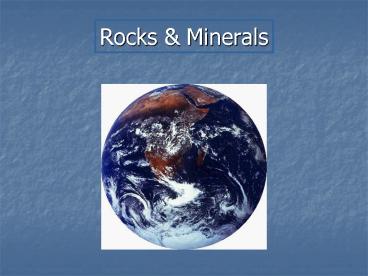Rocks - PowerPoint PPT Presentation
1 / 41
Title:
Rocks
Description:
Rocks & Minerals Classification of Sedimentary Rocks Clastic Rocks- Made of the fragments of previously existing rocks Organic Rocks- Come from organisms Chemical ... – PowerPoint PPT presentation
Number of Views:182
Avg rating:3.0/5.0
Title: Rocks
1
Rocks Minerals
2
Minerals
3
What is a Mineral?
- Naturally Occurring
- Inorganic
- Solid
- Definite Chemical Formula
- Definite Crystal Structure
4
Naturally Occurring
- Formed by natural processes not in the laboratory
- - Is an Ice Cube a mineral?
- - Is the ice on the windshield of a car a
- mineral?
5
Inorganic
- Formed by inorganic processes not living
- Does not contain chains of carbon atoms
6
Solid
- Not gas or liquid
- -H2O as ice in a glacier is a mineral, but
- water is not
7
Definite Crystal Structure
- Highly ordered atomic arrangement of atoms in
regular geometric patterns
Apatite
Feldspar
Diamond
Quartz
8
8
Definite Chemical Formula
- Minerals are expressed by a specific chemical
formula - -Gold (Au)
- -Calcite (CaCO3)
- -Quartz (SiO2)
- -Pyrite (FeS2)
9
Composition of the Earths Crust
- Eight Elements that make up over 98 of Earths
Crust - -Oxygen (O)
- -Silicon (SI)
- -Aluminum (Al)
- -Iron (Fe)
- -Calcium (Ca)
- -Sodium (Na)
- -Potassium (K)
- -Magnesium (Mg)
10
Where Do Minerals Come From?
Magma
Evaporation
11
How Are Minerals Identified?
- Color
- Luster
- Hardness
- Streak
- Density
- Crystal Shape
- Cleavage and Fracture
- Special Properties
12
Color
- Usually the first and most easily observed
- -Some minerals are always the same color
- -Some minerals can have many colors
13
Luster
- General appearance of a mineral surface in
reflected light
Glassy-Obsidian
14
Hardness
- Resistance to scratching by different items
scratchability - Mohs Hardness Scale
- gt2 fingernail
- 3 penny
- 5 Steel of a pocket knife
- 5.5 Window Glass
- 6.6 Steel of a file
- 7 quartz crystal
15
Mohs Mineral Hardness Scale
- 1) Talc
- 2) Gypsum
- 3) Calcite
- 4) Flourite
- 5) Apatite
- 6) Feldspar
- 7) Quartz
- 8) Topaz
- 9) Corundum
- 10) Diamond
Softest
1
5
2
6
3
7
Hardest
4
8
16
Streak
- The color of a finely powdered mineral
- Determined by rubbing the mineral on a piece of
unglazed porcelain (streak plate)
17
Density
- The amount of matter in a given space
(Mass/Volume)
18
Crystal Shape
- Minerals have a characteristic crystal shape
resulting from the atomic packing of the atoms
when the mineral is forming
19
Cleavage and Fracture
- Cleavage is the tendency of a mineral to split
or crack along parallel or flat planes - Fracture occurs when a mineral breaks at random
lines instead of at consistent cleavage planes.
Obsidian
No Cleavage
1 Direction of Cleavage
Conchoidal Fracture
20
Special Properties
- Magnetism (Magnetite)
- Glowing under ultraviolet light (Fluorite)
- Salty taste (Halite)
- Smell (Sulfur)
- Reaction to HCl (Calcite)
Magnetite
21
Economic Importance of Minerals
- Minerals are in many things we see and use
everyday such as bricks, glass, cement, plaster,
iron, gold
22
Every American Requires 40,000 Pounds of New
Minerals per Year
- at this level of consumption the average newborn
infant will need a lifetime supply of - -795 lbs of lead (car batteries, electric
components) - -757 lbs of zinc (to make brass, rubber, paints)
- -1500lbs of copper (electrical motors, wirings
- -3593 lbs aluminum (soda cans, aircraft)
- -32,700 lbs of iron (kitchen utensils,
automobiles, buildings) - -28,213 lbs of salt (cooking, detergents)
- -1,238,101 lbs of stone, sand, gravel, cement
(roads, homes, etc.)
23
Rocks
24
Rocks
- Made of two or more different minerals that have
been - cemented together
- squeezed and heated together
- melted and cooled together.
25
Types of Rocks
- Igneous
- Sedimentary
- Metamorphic
26
Igneous Rocks
- Most igneous rocks are produced deep underground
by the cooling and hardening of magma
27
Sedimentary Rocks
- Formed from the breaking apart of other rocks
(igneous, metamorphic, or sedimentary rocks) and
the cementation, compaction and recrystallization
of these broken pieces of rock
28
Fact about the Mississippi River
- Did You Know?
- The Mississippi River carries an average of
436,000 tons of sediment each day - It moves an average of 159,000,000 tons of
sediment a year
29
Metamorphic Rocks
- Formed from heat and pressure changing the
original or parent rock into a completely new
rock. The parent rock can be either sedimentary,
igneous, or even another metamorphic rock.
30
The Rock Cycle
- The diagram of the rock cycle shows how the
earth's rocks are changed again and again
31
Classification of Igneous Rocks
- Composition-refers to the minerals that make up
the rock - Texture-shape, size, arrangement and distribution
of minerals that make up the rock
32
Composition
- Extrusive- Formed from lava volcanic
- Intrusive- Formed deep within the earth
Obsidian
Pumice
33
Textures
- Coarse-grained
- Porphyritic
- Glassy
- Fine-grained
Obsidian
Granite
Granite
Basalt
34
Classification of Sedimentary Rocks
- Clastic Rocks- Made of the fragments of
previously existing rocks - Organic Rocks- Come from organisms
- Chemical Rocks- Formed by inorganic processes
such as evaporation
35
Clastics Rocks
- Conglomerate
- Sandstone
- Mudstone
36
Organic Rocks
- Limestone
Coquina
Fossiliferous Limestone
37
Chemical Rocks
- Limestone
38
Metamorphic Rocks
- Foliated- Parallel alignment of flattened mineral
grains and pebbles - Unfoliated-Rocks that are not banded and do not
break into layers
39
Foliated
Gneisse
40
Unfoliated
Marble
41
Distribution of Rocks in the U.S.































